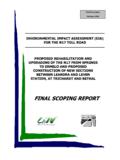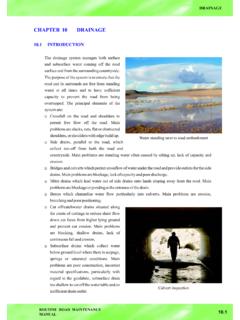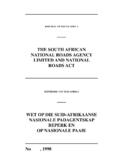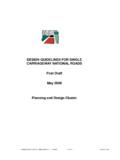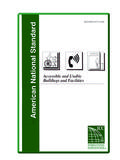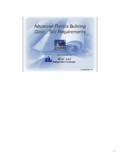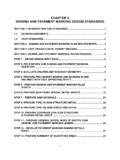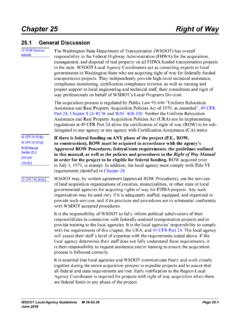Transcription of CHAPTER 2 STUDY APPROACH AND …
1 Proposed N2 Wild Coast Toll Highway - Final EIR, Part A, CHAPTER 2: STUDY APPROACH and methodology CHAPTER 2 STUDY APPROACH AND methodology . This CHAPTER outlines the guiding principles and legislative requirements underpinning the EIA and describes the STUDY APPROACH and methodology . It also provides a summary of the public consultation process undertaken and outlines the way forward in terms of decision-making by the relevant authorities. Specialist studies undertaken during the Impact Assessment phase are listed, and the process whereby the information gathered in these studies was integrated into an overall assessment of the proposed project is described. Assumptions and limitations applicable to the EIA process are listed at the end of the CHAPTER . EIA LEGISLATIVE CONTEXT AND GUIDING PRINCIPLES. This section provides a description of the key legal considerations of direct relevance to the undertaking of the EIA. As mentioned in Section , the application for authorisation of this proposed project was made in terms of Government Notice R1183 of 5 September 1997 (as amended) promulgated under the ECA the ECA EIA Regulations.
2 The new EIA Regulations, promulgated under NEMA, as amended, which came into effect on 3 July 2006. (Government Notices R385, R386 and R387 of 21 April 2006 the NEMA EIA Regulations ), make provision for transitional arrangements in order to accommodate applications, such as this STUDY , which commenced prior to the promulgation of the NEMA EIA Regulations and were still pending at the time the NEMA EIA Regulations took effect. Regulation 84(1) of Government Notice R385 stipulates that where an application was submitted in terms of the ECA EIA Regulations, and was still pending at the time the NEMA EIA Regulations took effect, it must, despite the repeal of the previous regulations, be dispensed with in terms of the previous regulations as if the previous regulations were not repealed . In terms of Regulation 84(3) an authorisation issued following an application in terms of Regulation 84(1) must be regarded to be an environmental authorisation issued in terms of these Regulations.
3 THE ENVIRONMENT CONSERVATION ACT. Section 21 of the ECA, as amended, provides for the control of identified activities that may have a substantial detrimental effect on the environment. These activities are listed in Government Notice R1182 of 5 September 1997 (Schedule 1), as amended. Listed activities applicable to the proposed project (or particular stretches of the route) include the following: The construction, erection or upgrading of roads and associated structures (1d);. With regard to any substance which is dangerous or hazardous and is controlled by national legislation storage and handling facilities for any such substance [storage and handling of diesel and oil during construction, if required] (1cii);. The change of land use from agricultural or zoned undetermined use or an equivalent zoning to any other land use (2c);. The reclamation of land, including wetlands, below the high-water mark of the sea, and in inland waters (7); and Scheduled processes listed in the Second Schedule to the Atmospheric Pollution Prevention Act, 1965 (No.)
4 45 of 1965) (9). The ECA prohibits such activities until written authorisation is obtained from the Minister or his delegated authority. Such authorisation, which may be granted subject to conditions, will only be considered once there has been compliance with the ECA EIA Regulations, as amended. CCA Environmental (Pty) Ltd 2-1 December 2009. Proposed N2 Wild Coast Toll Highway - Final EIR, Part A, CHAPTER 2: STUDY APPROACH and methodology NATIONAL ENVIRONMENTAL MANAGEMENT ACT. Section 2 of NEMA, as amended, sets out a range of environmental principles that are to be applied by all organs of state when taking decisions that significantly affect the environment. Included amongst the key principles is that all development must be socially, economically and environmentally sustainable and that environmental management must place people and their needs at the forefront of its concern, and serve their physical, psychological, developmental, cultural and social interests equitably.
5 NEMA also provides for the participation of I&APs and stipulates that decisions must take into account the interests, needs and values of all I&APs. CHAPTER 5 of NEMA, as amended, outlines the general objectives and implementation of Integrated Environmental Management (IEM). IEM provides a framework for the integration of environmental issues into the planning, design, decision-making and implementation of plans and development proposals. Section 24(4) provides the minimum requirements for procedures for the investigation, assessment and communication of the potential impact of activities. Further details of these principles and objectives of NEMA, as amended, are provided in Section NATIONAL HERITAGE RESOURCES ACT. Section 38(1) of the National Heritage Resources Act, 1999 (NHRA, Act No. 25 of 1999) lists development activities that would require authorisation by the responsible heritage resources authority. Activities considered applicable to the proposed project (or particular stretches of the route) include the following: The construction of a road, wall, powerline, pipeline, canal or other similar form of linear development or barrier exceeding 300 m in length.
6 The construction of a bridge or similar structure exceeding 50 m in length; and Any development or other activity which will change the character of a site. The NHRA requires that a person who intends to undertake a listed activity notify the relevant provincial heritage authority at the very earliest stages of initiating such a development. The relevant provincial heritage authority would then in turn, notify the person whether a Heritage Impact Assessment Report should be submitted. However, according to Section 38(8) of the NHRA, a separate report would not be necessary if an evaluation of the impact of such development on heritage resources is required in terms of the ECA or any other applicable legislation. The decision-making authority should, however, ensure that the heritage evaluation fulfils the requirements of the NHRA and take into account in its decision- making any comments and recommendations made by the relevant heritage resources authority.
7 OTHER RELEVANT LEGISLATION. Other relevant legislation and policies relevant to the EIA and proposed project are discussed in Section These include, but are not limited to, the following: Noise Control Regulations: Environment Conservation Act, 1989 (Act No. 73 of 1989);. National Water Act, 1998 (Act No. 36 of 1998);. National Environmental Management: Air Quality Act, 2004 (Act No. 39 of 2004);. Etc. CCA Environmental (Pty) Ltd 2-2 December 2009. Proposed N2 Wild Coast Toll Highway - Final EIR, Part A, CHAPTER 2: STUDY APPROACH and methodology EIA methodology . This section outlines the methodology followed during the EIA process. The EIA was undertaken in two phases, namely (1) a Scoping STUDY phase and (2) an Impact Assessment phase. SCOPING STUDY PHASE. The specific objectives of the Scoping STUDY were as follows: To undertake a comprehensive audit of all the issues and concerns raised during the previous EIA's Scoping STUDY , Impact Assessment and Appeals phases in order to ensure that all relevant issues and concerns are adequately addressed.
8 To provide Terms of Reference for specialist studies in order to update existing information and/or to address identified shortcomings and/or gaps;. To provide a reasonable opportunity for the involvement of I&APs (including relevant authorities) in the STUDY ;. To inform the way forward in the EIA process; and Through the above, to ensure informed, transparent and accountable decision-making. Existing information considered to be adequate and credible was used, as appropriate, in formulating the scope of the work and compiling the necessary documentation. The Scoping STUDY was undertaken with an initial round of public consultation aimed at providing Interested and Affected Parties (I&APs) an opportunity to comment on the proposed new EIA process only. The distribution of the Draft Scoping Report (DSR) and associated public consultation process (refer to Section and Volume 2, Appendix 10 of the FSR) provided I&APs adequate opportunities to raise any issues and concerns on the proposed project and Scoping STUDY .
9 The FSR provides a detailed description of the various tasks undertaken between April 2005 and March 2007 as part of the Scoping STUDY and associated public consultation process. Box provides a summary of the public consultation process while Figure provides a summary of the opportunities provided for involvement of I&APs in the Scoping STUDY . BOX ACTIVITIES UNDERTAKEN AS PART OF THE PUBLIC CONSULTATION PROCESS OF THE SCOPING STUDY . 1. Compilation of I&AP database The previous EIA STUDY 's database was used as a basis for compilation of a comprehensive initial project database. This database included those parties who appealed against the previous authorisation of the proposed project. There were approximately 3 700 I&APs on the initial project database. During the course of the Scoping STUDY the list of I&APs was continuously supplemented and updated. There were 10 139. I&APs on the database when the FSR was submitted to the relevant authorities. 2. Distribution of the Background Information Document (BID).
10 A BID, together with a covering letter informing I&APs of the commencement of the new application for environmental authorisation and the EIA. process was distributed to 3 721 I&APs on the initial database on 5 and 6 August 2005. It was also placed on CCA's website. The BID invited I&APs to submit comment on the new EIA process only. It was indicated that comments on the proposed project would only be sought on release of the DSR. The BID provided background information on the proposed project, a map showing the extent of the proposed project, key shortcomings/gaps that needed to be addressed in the new EIA process and a description of the anticipated EIA process. The BID was made available in English, Afrikaans, isiZulu and isiXhosa. 3. Public notification of commencement of new application and EIA process At the beginning of August 2005, advertisements announcing the commencement of the new application for environmental authorisation and associated EIA process were placed in the following national, regional and local newspapers: the Sunday Times; Daily Dispatch; Burger East.

